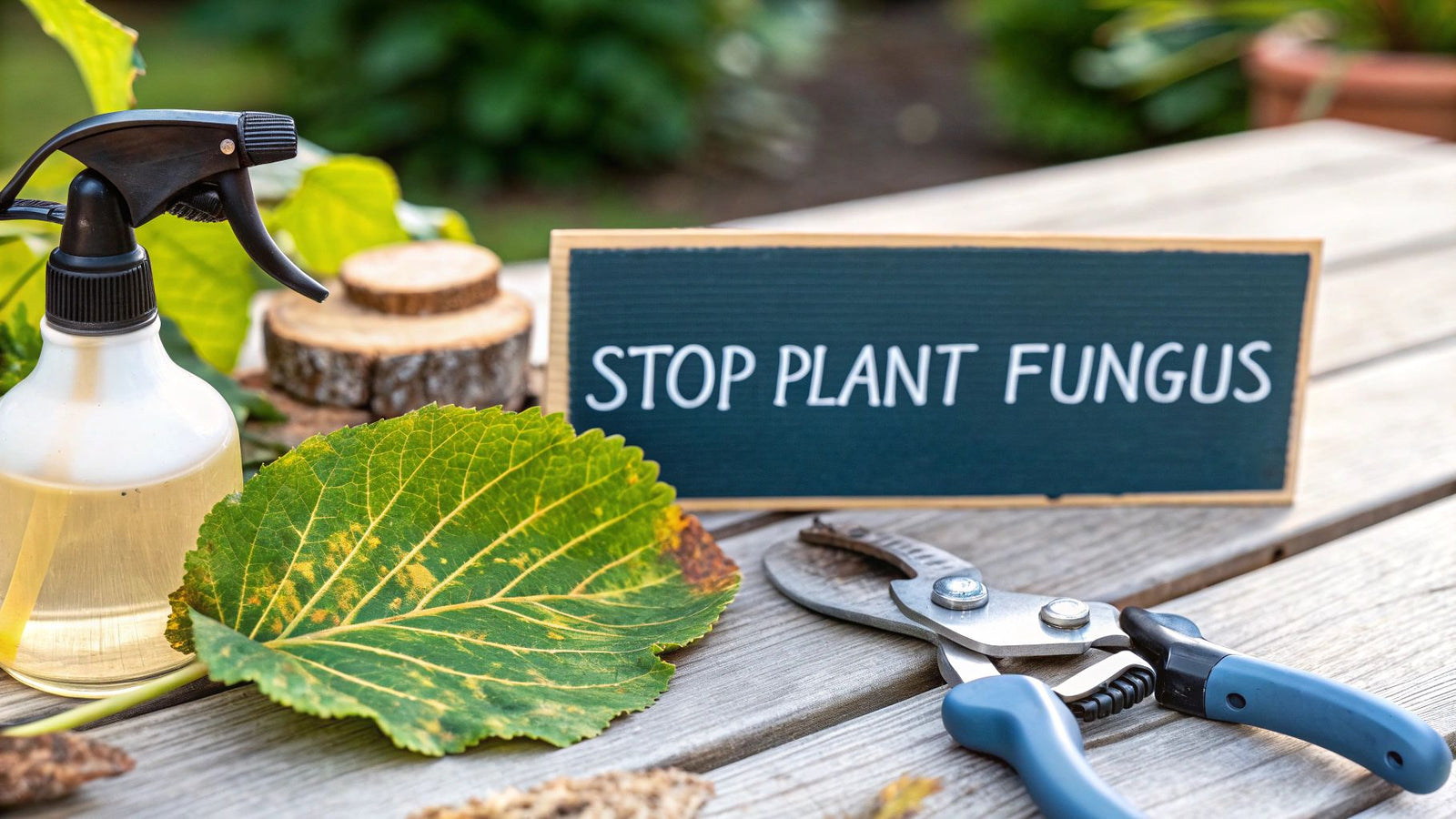
When you first spot signs of fungus on a plant, the key is to act fast. Your immediate goals are simple: isolate the affected plant, snip off the diseased parts, and give it some breathing room by improving air circulation. Taking these initial steps right away can stop an outbreak in its tracks, preventing it from spreading to your other healthy plants while you figure out a long-term fix.
Your First Steps to Stop Plant Fungus Fast
It’s always a little heartbreaking to find a fuzzy white coating or weird spots on a plant you’ve been carefully nurturing. But don't panic. How you react in the first few minutes can completely change the outcome for your plant—and the rest of your collection.
Think of it like plant triage. The absolute first thing you need to do is get that plant into quarantine. Move it far away from its neighbors to cut off the easy transmission of fungal spores through the air or by accidental contact.
Prune and Improve Airflow
Once the plant is isolated, grab a pair of clean, sharp pruning shears. Carefully snip off every leaf, stem, or flower that shows any sign of infection. It’s crucial that you throw this material directly into the trash, not your compost pile, where the spores could survive and spread later.
Here’s a pro tip: after every single cut, wipe your shear blades with rubbing alcohol. This prevents you from accidentally spreading the microscopic spores to healthy tissue on the same plant.
Fungus loves damp, still air, so your next move is to disrupt that environment. If you can, space your plants out more to let air move between them. For indoor plants, even a small, gentle fan can make a huge difference by keeping the air circulating and the leaf surfaces dry.
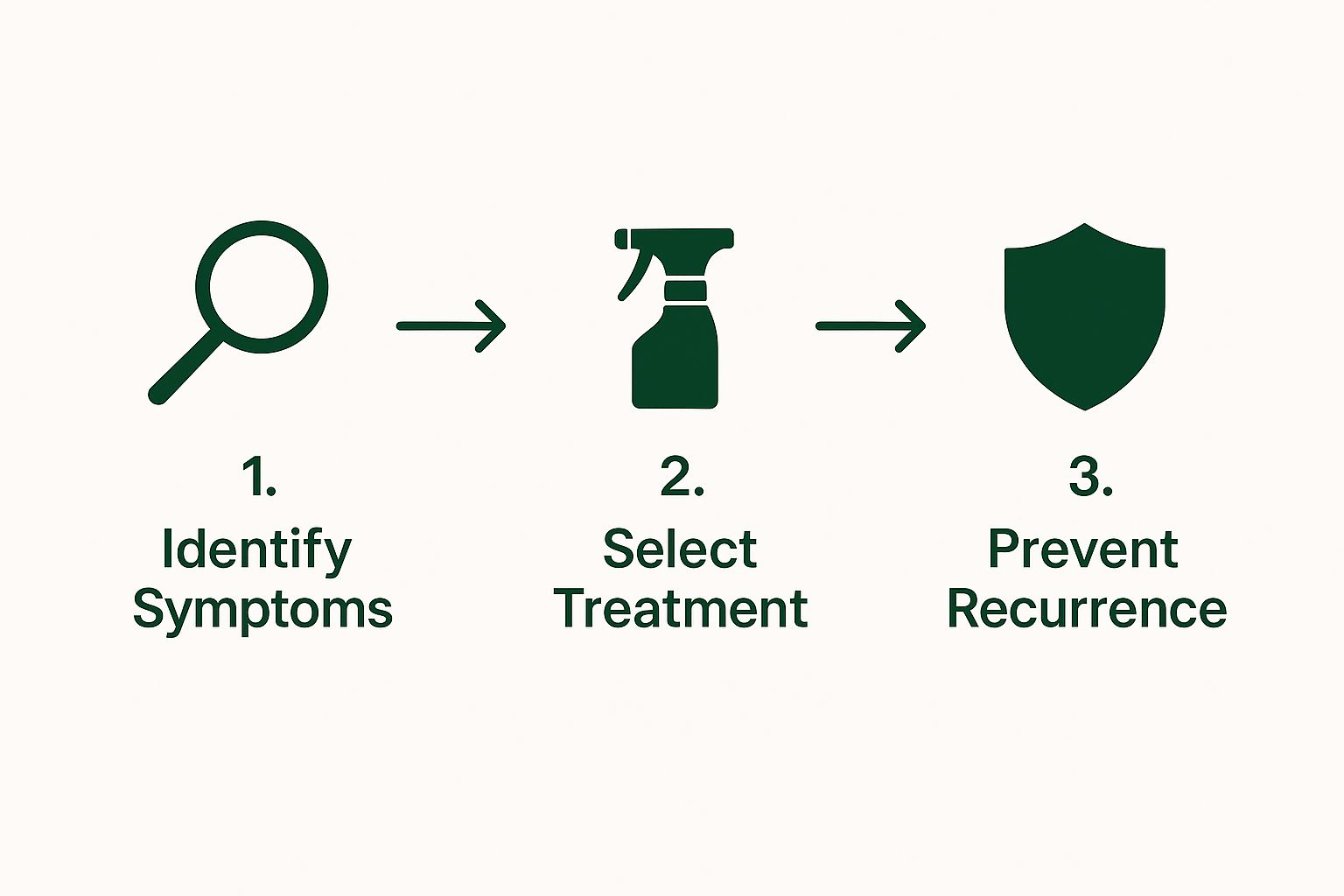
This process isn't just about applying a fungicide and calling it a day. As you can see, successful management starts with quick action, moves to treatment, and, most importantly, transitions into long-term prevention.
Tackling fungus isn't just a one-time fix; it's about disrupting the conditions that allow it to grow. Addressing the environment—dampness and poor airflow—is just as important as applying a fungicide.
To give you a quick reference, here’s a table summarizing the most critical first moves.
Immediate Actions for Fungal Infections
| Action Item | Why It's Critical | When to Do It |
|---|---|---|
| Isolate the Plant | Fungal spores spread easily to nearby plants. Isolation contains the problem immediately. | The very moment you suspect a fungal infection. |
| Prune Diseased Areas | Removing infected parts reduces the overall fungal load and stops its progression. | Right after isolating the plant, before any treatment. |
| Increase Air Circulation | Fungi thrive in stagnant, humid air. Good airflow makes it harder for them to survive. | Immediately. A small fan or better spacing helps. |
| Sanitize Your Tools | Prevents you from accidentally spreading the infection to healthy parts of the plant. | After every single cut you make into infected tissue. |
Following these triage steps buys you valuable time and sets the stage for a more targeted and effective treatment plan.
Developing a holistic approach is always the best strategy for a thriving garden. For more on creating a resilient environment for your plants, you can learn about smarter garden pest control for healthy plants from other experts in the field.
Getting to Know the Common Culprits: How to Identify Plant Fungi
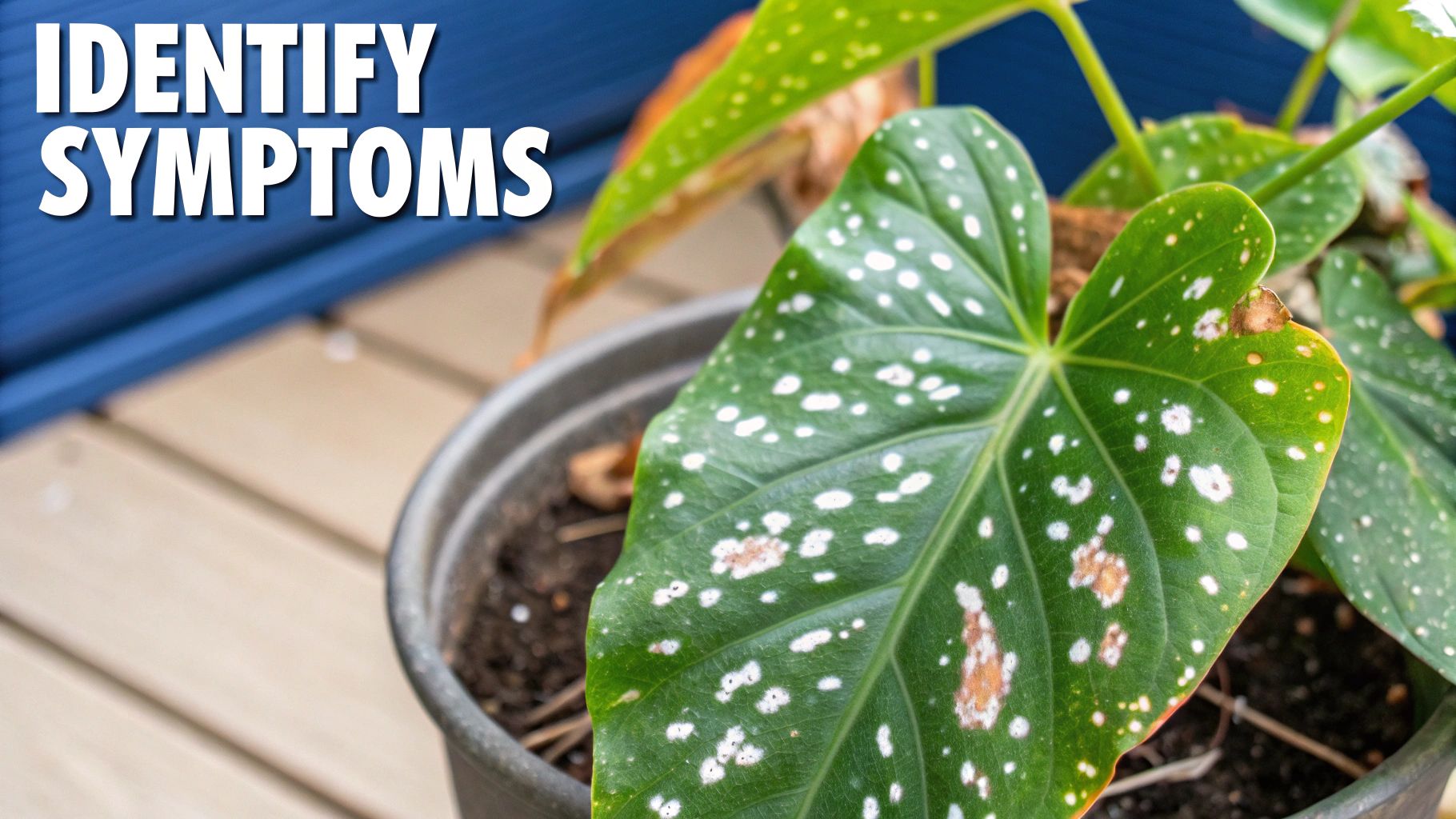
Before you can treat a plant fungus, you have to play detective. Grabbing the wrong remedy is more than just a waste of time; it can stress your plant further and leave it open to more problems. Pinpointing the exact fungus is your single most important step toward bringing your plant back to health.
Think of yourself as a plant doctor—you need a proper diagnosis before you can prescribe the right medicine. Each fungus leaves its own distinct visual calling card. Learning to read these signs will give you the confidence to choose the most effective treatment.
The Tell-Tale Signs of Powdery Mildew
One of the easiest fungal diseases to spot is powdery mildew. It looks just like someone dusted your plant with flour, creating a white or gray powdery coating on the leaves, stems, and sometimes even the flowers. It might start as a few small, round spots, but it can spread frighteningly fast, eventually blanketing entire leaves.
This fungus loves shady spots with stagnant air. While it’s not too picky about its victims, you’ll frequently find it on:
- Lilacs and Roses: These garden favorites are classic targets.
- Zinnias and Begonias: Their tender foliage is especially susceptible.
- Cucumbers and Squash: A notorious headache for vegetable gardeners.
A simple touch test can help confirm your suspicion. If the white stuff rubs off easily on your finger, you're almost certainly dealing with powdery mildew.
Expert Tip: While powdery mildew looks awful, it's often just a cosmetic issue at first. Don't panic. But if you let it go, it will eventually block sunlight, stress the plant, and cause leaves to yellow and drop.
Spotting Black Spot and Rust
Two other common intruders are black spot and rust. Gardeners sometimes mix them up, but they have key differences once you know what to look for.
Black spot shows up as dark, circular splotches on the top of the leaves, almost always surrounded by a distinct yellow ring or halo. As it gets worse, the spots grow and merge until the whole leaf yellows and falls off. Roses are practically magnets for this disease.
Rust, true to its name, creates small, reddish-orange pustules. The key difference? They usually appear on the undersides of the leaves. If you wipe one of these bumps with a white tissue, it will leave behind an orange, rusty-looking smear. You’ll see this fungus pop up on plants like daylilies, hollyhocks, and many types of lawn grass.
Root Rots: The Trouble Hiding Below
Not every fungal problem is out in the open. Root rot is a stealthy killer that works underground, usually thriving in soggy, poorly drained soil. It's often caused by soil-borne fungi like Armillaria (also known as oak root fungus).
The above-ground symptoms can be tricky because they look a lot like drought stress—think wilting, yellowing leaves, and stunted growth. The only way to know for sure is to take a look at the roots themselves. Gently ease the plant from its pot or dig carefully around the base.
Healthy roots are firm and creamy white. Rotted roots, on the other hand, will be dark brown or black, mushy to the touch, and might even smell sour or rotten. While famously a problem for succulents, root rot can strike almost any plant, from houseplants to mature trees. The lessons on root health in our guide on how to identify and solve common succulent issues are surprisingly helpful for all kinds of plants.
7 Proven Ways to Treat Plant Fungus
Here are 7 of the best methods for treating fungus on your plants, from simple organic solutions to more powerful chemical interventions for stubborn cases.
1. Harness the Power of Neem Oil
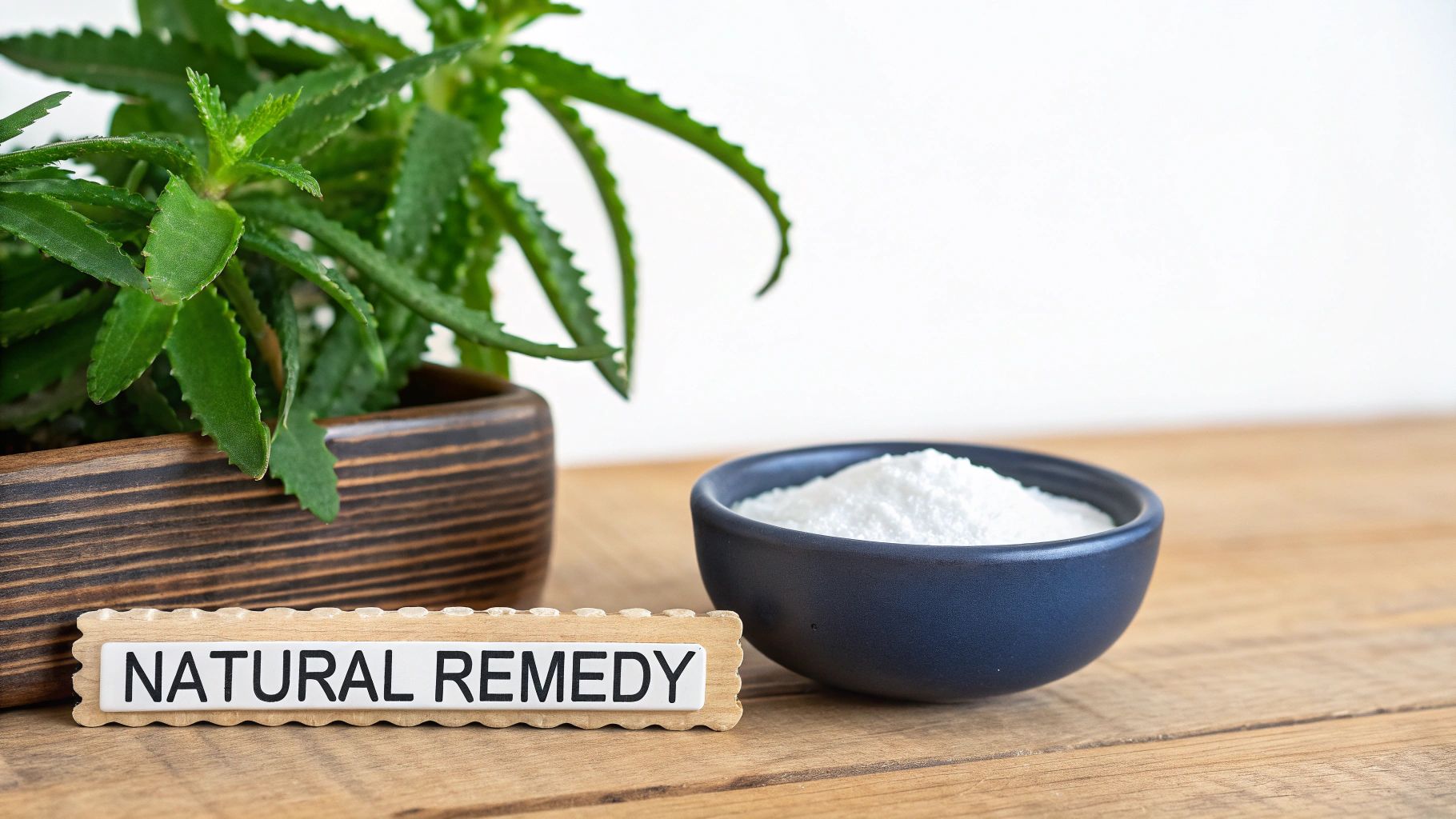
There's a good reason neem oil is a legend in organic gardening circles. It's a triple threat: a fungicide, insecticide, and miticide all in one. The magic ingredient is azadirachtin, which stops fungi from growing and spreading. I find it works wonders on surface issues like powdery mildew, rust, and black spot.
To mix up a batch, you just need a few things:
- 100% Cold-Pressed Neem Oil: Quality matters here, so look for a pure product.
- Mild Liquid Soap: This is your emulsifier, which is just a fancy word for something that helps oil and water mix.
- Warm Water: Helps everything dissolve together smoothly.
My Go-To Neem Oil Spray Recipe:
- In a one-quart spray bottle, combine 1 teaspoon of neem oil and 1/2 teaspoon of mild liquid soap (unscented castile soap is perfect).
- Top it off with warm water.
- Shake it like you mean it until it’s all one milky consistency.
Make sure you drench the plant—tops and bottoms of the leaves, stems, everything. The best time to spray is early morning or late evening to avoid sun-scald on the leaves. Reapply every 7 to 14 days, or after a good rain, until the problem clears up.
2. Use Baking Soda to Change Leaf pH
It sounds almost too simple, but baking soda (sodium bicarbonate) is a fantastic fungal fighter. It works by making the leaf surface more alkaline, creating an environment where fungal spores just can't take hold. This makes it an amazing preventative tool and a solid treatment for active powdery mildew.
By simply raising the pH on a leaf, you make it uninhabitable for fungi like powdery mildew. It’s a classic example of how a small environmental change can have a massive impact on a pest.
For a reliable spray, mix 1 tablespoon of baking soda and 1/2 teaspoon of mild liquid soap into one gallon of water. Give it a good stir and spray your plants every week or two. A word of caution: always test it on a small leaf first. Some delicate plants can find it a bit harsh.
3. Apply Horticultural and Dormant Oils
Horticultural oils, which come in lighter "summer" and heavier "dormant" varieties, are basically highly refined oils that smother fungal spores and tiny insects on contact. They are a great weapon against powdery mildew, sooty mold, and other fungi that live on the plant's surface.
- Dormant Oils: These are heavier oils meant for the off-season. Apply them in late fall or winter when your plant is dormant to kill off any spores trying to overwinter on fruit trees or shrubs. This is a crucial step for preventing next year's problems.
- Summer or Superior Oils: These are much lighter and safer to use during the growing season, but only when temperatures are below 85°F (29°C) to avoid frying the leaves.
The label is your best friend here. Timing is everything with oils, so read the directions carefully to avoid accidentally harming your plants.
4. Fight Back with Sulfur-Based Sprays
Sulfur is one of the oldest fungicides known to gardeners, and for good reason—it still works. It's a powerhouse against powdery mildew, rust, and leaf spot, and even helps with certain mites. It works on contact, disrupting the fungus's basic metabolism.
You can find sulfur as a fine dust or as a wettable powder that you mix with water. It's most effective when you apply it before a disease really gets out of hand, so think of it as a protective shield.
Important Cautions for Sulfur Use:
- Heat is the enemy. Never apply sulfur when the temperature is creeping above 90°F (32°C), or you risk burning your plants.
- Sulfur and oil do not mix. Don't apply sulfur within 2-4 weeks of an oil spray; the combination is phytotoxic, meaning it’s poisonous to the plant.
- Some plants are sensitive. Avoid using it on things like apricots, cucumbers, and some types of squash.
5. Use Myclobutanil for Inside-Out Protection
When a fungus is already well-established, you need something that works from the inside out. That’s where a systemic fungicide like myclobutanil comes in. The plant actually drinks it up, moving the active ingredient throughout its entire system—stems, leaves, and all.
This internal protection is a game-changer for diseases like powdery mildew, rust, and black spot. The best part? Because it’s inside the plant, rain won't wash it away, giving you much longer-lasting control. It’s my go-to for saving roses and other ornamental shrubs when an infection has really taken hold.
- Read the Label—Seriously: The product label is your bible. It dictates which plants are safe and the precise mixing ratios. Don't guess.
- Mind the Harvest Window: For anything you plan to eat, the label will list a pre-harvest interval (PHI). This is the mandatory waiting period between spraying and harvesting to ensure the produce is safe to consume. This is non-negotiable.
6. Apply Chlorothalonil for a Protective Shield
Think of chlorothalonil as a coat of armor for your plants. It's a broad-spectrum contact fungicide, which means it doesn't get absorbed. Instead, it forms a protective film on the leaf's surface that stops fungal spores from ever germinating or getting inside the plant tissue.
It’s fantastic for preventing a wide array of common diseases like leaf spot, blight, and anthracnose. Because it just sits on the surface, you'll need to reapply it after a good downpour or if you use overhead sprinklers. I often use it as a preventative spray when I see a long stretch of humid, muggy weather in the forecast—prime time for fungal outbreaks.
Safety First: I can't stress this enough. When you're mixing or spraying any chemical fungicide, wear your gear: gloves, long sleeves, and safety glasses are a must. Always mix it in a well-ventilated space (outdoors is best) and keep kids and pets far away until everything is dry.
7. Use Captan for Guarding Fruits and Berries
Captan is another old-school, reliable contact fungicide that gardeners have trusted for decades. It's particularly effective at protecting fruit trees, berries, and ornamentals from diseases like scab, brown rot, and various leaf spots that can ruin a harvest.
Using these fungicides responsibly is part of a much bigger picture. Protecting our food sources is a massive global effort, and it’s no surprise the worldwide fungicide market was valued at USD 23.9 billion. It’s even projected to hit USD 32.3 billion by 2029, largely driven by the need to ensure global food security. As new regulations come into play, the industry is shifting toward developing safer chemicals and more bio-fungicides. You can discover insights on the global fungicide market and see where the trends are headed.
To get the job done right, spray thoroughly until the leaves are wet but not dripping. Don't forget to get the undersides of the leaves—that's where fungi love to hide. If you follow the directions to the letter, you can knock out even a stubborn plant fungus and get your garden back on track.
Keeping Fungus from Coming Back for Good
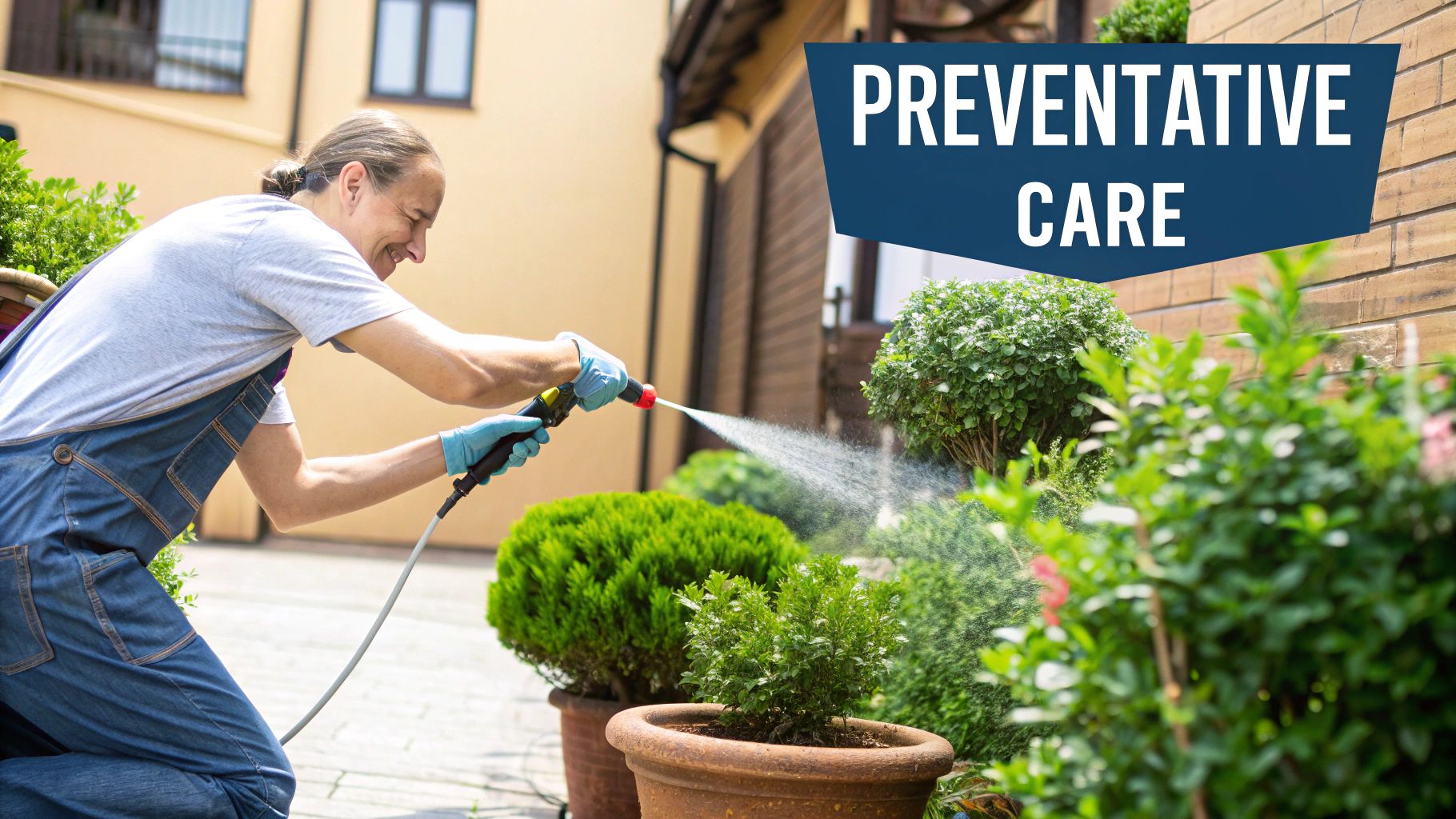
It’s one thing to knock out a fungal infection; it’s another to make sure it stays gone. The real victory lies in creating a garden environment where fungus simply can't thrive. Honestly, this proactive approach will save you a world of time, stress, and repeated treatments down the road.
Think of it this way: fungal spores are basically everywhere, all the time. They're just microscopic opportunists waiting for the perfect conditions—damp leaves, high humidity, and still air—to start their party. Your job is to be the ultimate party pooper by disrupting those conditions.
Master Your Watering Game
If there's one thing to get right, it's this. How you water is probably the most critical factor in preventing fungus. Why? Because most fungal spores need a film of water on the leaf's surface to germinate.
-
Water the soil, not the plant. I can't stress this enough. Aim your hose or watering can directly at the base of your plants. A soaker hose is a fantastic investment for this, as it delivers water straight to the roots where it belongs.
-
Timing is everything. The best time to water is early in the morning. This gives the leaves all day to dry in the sun, so they aren't sitting wet overnight—which is like rolling out a welcome mat for powdery mildew and other fungal diseases.
Just changing these two watering habits can dramatically lower the risk of an outbreak.
Let the Air Flow
Fungus loves stagnant, humid air. You can fight back by simply improving the airflow around your plants. It’s like opening a window in a stuffy room; it whisks away humidity and helps dry things out quickly.
The easiest way to do this is to give your plants some breathing room. When you're planting new additions, check the tag for their mature size and space them out accordingly. For plants already in the ground, don't hesitate to prune out some of the dense, interior foliage. This lets a good breeze pass through, which is a major deterrent for fungus.
Think of good spacing as built-in social distancing for your plants. It breaks up the "leaf-to-leaf" highway that spores use to travel, stopping a small problem before it can explode across your whole garden.
Be a Tidy Gardener
A clean garden is a healthy garden. Piles of dead leaves, fallen blossoms, and other plant debris are the perfect place for fungal spores to hide and wait out the winter.
Get into the habit of cleaning up around the base of your plants. This is an absolute must in the fall before winter sets in. A solid end-of-season cleanup prevents diseases from getting a head start next spring. And remember, this infected material goes in the trash, not your compost bin, to avoid spreading the problem.
If you want to take your defense to the next level, you can introduce beneficial organisms into your garden ecosystem. To dive deeper into this, check out some guides on natural pest control for plants, as many of those strategies are great for deterring fungus too. By weaving these practices together, you’ll build a resilient garden that naturally fights off disease.
Common Questions About Treating Plant Fungus
Even with a solid game plan, you're bound to have questions when you're in the thick of a fungal fight. When your plants are on the line, getting straight answers to those nagging problems can be a real game-changer. Let's dig into some of the most common questions I hear from fellow gardeners.
Can a Plant Actually Recover from a Fungal Infection?
Yes, they absolutely can. Most plants are surprisingly resilient and can bounce back from fungal diseases, but you have to catch it early. The real trick is to combine swift action—like snipping off diseased leaves and getting more air moving—with the right treatment for the specific problem.
Keep in mind, the leaves and stems that are already badly damaged won't magically repair themselves; you'll need to prune those away. This lets the plant focus its energy on new, healthy growth. Once you've fixed the environmental issue that let the fungus get a foothold, your plant stands a fantastic chance of a full recovery. Just be sure to keep a close eye on it afterward to catch any signs of a comeback.
Are Fungicides Safe for My Vegetable Garden?
This is a big one, and the answer hinges entirely on which product you're reaching for.
- Organic Options: Things like neem oil or sprays made with potassium bicarbonate are generally considered safe to use on plants you plan to eat. Still, it's always a good habit to give your harvest a thorough wash before it hits the kitchen counter.
- Chemical Fungicides: With these, the label is the law. It has to tell you if the product is approved for fruits and vegetables. Even more crucial, it will list the pre-harvest interval (PHI)—that’s the non-negotiable waiting period between your last spray and when you can safely harvest. If a label doesn't explicitly say it's safe for edibles, don't even think about using it on them.
Always assume a fungicide is unsafe for your vegetable garden unless the label says otherwise and gives you a clear pre-harvest interval. Your family's safety is what matters most.
How Often Should I Reapply Fungicide?
There's no single answer here—it really depends on the fungicide you're using and what the weather has been doing. Organic treatments, for example, don't stick around as long.
You'll likely need to reapply neem oil or baking soda sprays every 7 to 14 days to keep them working. A good, hard rain will wash them right off, so you'll definitely need to reapply after a downpour.
Chemical fungicides, on the other hand, usually provide longer protection, often on a 14 to 21-day schedule. Once again, your product label is the ultimate authority. It will give you the exact timing you need to be both effective and safe.
Why Does Fungus Keep Coming Back?
If you feel like you're fighting the same fungal battle over and over, the underlying environmental problem probably hasn't been solved. Fungal spores are a natural part of the environment, just waiting for the perfect conditions to spring to life.
A recurring fungus almost always points back to one of three issues:
- Dampness: Leaves are staying wet for too long, a common result of watering from above.
- High Humidity: The air around your plants is just too muggy.
- Poor Air Circulation: Your plants are packed too tightly, creating stagnant, damp air pockets.
Just treating the spots on the leaves without changing these conditions is like mopping up a puddle without fixing the leaky pipe. The problem will always come back. To truly break the cycle, you need to shift your gardening habits to create an environment where fungus simply can't thrive.
Ready to create a garden that's healthy from the ground up? At Homegrown Garden, we provide high-quality heirloom seeds, starter kits, and all the guidance you need to succeed. Explore our curated collections and start building your thriving home garden today.



